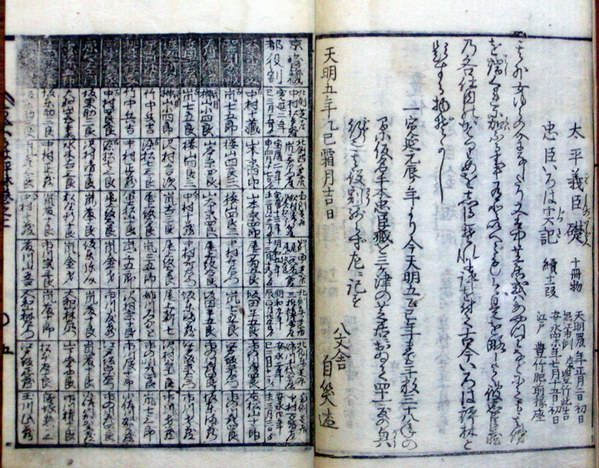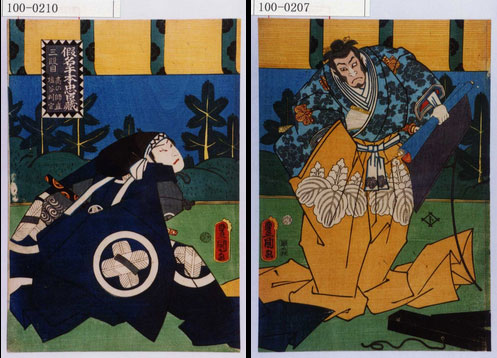Chûshingura On Stage And In Print
Part I: Theater Texts and Color Woodblock Prints (Butler Rare Book Library)
The spring of 2003 marks the 300th anniversary of the culmination of the historical Akô Incident of 1701-03, when forty-six rônin were executed by seppuku for having avenged the death of their lord, Asano Takumi-no-kami, by killing his enemy Kira Kozuke-no-suke after 22 months of plotting. In the ensuing three centuries, their story has been retold endlessly, constantly expanded and embellished, to become Japan’s “national legend.”
The single most crucial event in this process of embellishment occurred in the autumn of 1748, almost a half-century after the initial incident, when a puppet play entitled Kanadehon Chûshingura (translated into English by Donald Keene as “The Treasury of Loyal Retainers”) was staged in Osaka. It was an instant success, and within months the play had become a hit on the kabuki stage as well. Chûshingura has remained the most frequently performed play in the repertoire of both those genres of traditional Japanese theater throughout the intervening two and a half centuries.
This exhibition celebrates the theatrical tradition of Chûshingura with a display of the ways in which the play was promoted in print in the eighteenth and nineteenth centuries. These remain the only detailed records of the Japanese stage tradition in an era before modern techniques of recording in real time became available in the early twentieth century.
The books and prints displayed here are from the collections of the Tsubouchi Memorial Theatre Museum at Waseda University and the Waseda University Library in Tokyo. The exhibition is intended to mark an agreement between the libraries of Columbia University and Waseda University, signed in May 2002, to extend cooperation over a wide range of mutual interests.
This exhibition is made possible by a grant from the Weatherhead Program Development Fund of the East Asian Institute, Columbia University, and with the cooperation of the Waseda University Library and the Tsubouchi MemorialTheatre Museum.
2. The First Jôruri Texts on the 47 Rônin
The Japanese puppet theater that is today known as “bunraku” began in the 17th century as a combination of the movements of puppets on a stage with oral narration to samisen accompaniment, in a style known as “jôruri” (after a character in an early tale). The texts for this “puppet jôruri” (ayatsuri jôruri) came to be written with two ends in mind. First, they served as the libretto for the narrator (tayû) who sat to one side of the puppet stage, chanting in a style known as gidayû-bushi, originally employed by Chikamatsu Monzaemon, one of the foremost puppet playwrights in the seventeenth century. At the same time, the jôruri texts were printed and sold as books be read independently, both for pleasure and as a way of studying jôruri chanting by amateurs. The printed texts displayed here were known as maruhon, “round books,” perhaps after the distinctive round script in which they were written.
The texts of the plays featured here―Goban Taiheiki (ca 1710, by Chikamatsu), Onikage Musashi abumi (1713, by his rival Ki no Kaion), and Chûshin kogane tanzaku (1732, by a team led by Namiki Sôsuke)―are all early works based directly on the story of the revenge of the 47 Rônin of Akô. Since it was forbidden to deal openly in print with such recent political events, the time was transposed to the Kamakura period (13th-14th c.), and the names changed (if only slightly). Although no longer performed, each of these plays is noteworthy for the influence it exerted on the plot and characters of Kanadehon Chûshingura.
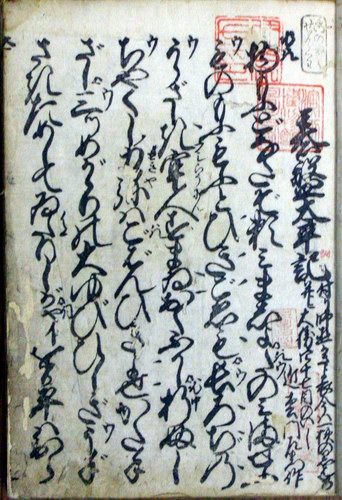 2-A
2-A
Chikamatsu Monzaemon (1653-1724)
Goban Taiheiki
First performed ca. 1710, Takemoto Theater, Osaka.
Jôruri libretto
Tsubouchi Memorial Theatre Museum ni 10-1768
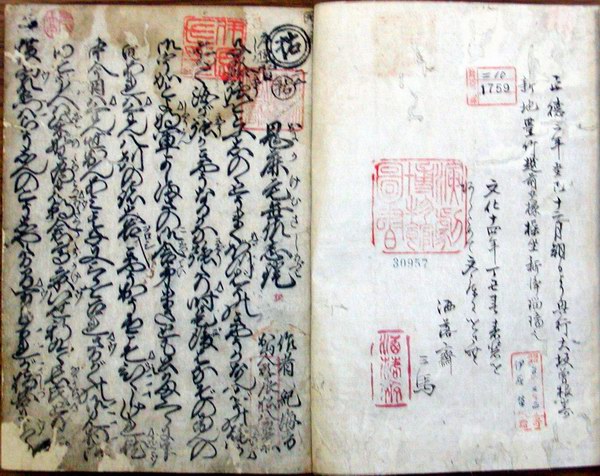
2-B
Ki no Kaion (1663-1742)
Onikage Musashi abumi
First performed 1713.01.11, Toyotake Theater, Osaka
Jôruri libretto
Tsubouchi Memorial Theatre Museum ni 10-1759

2-C
Namiki Sôsuke (1695-1751), Ogawa Bunsuke, and Yasuda Abun (fl. 1720s-1740s)
Chûshin kogane no tanzaku
First performed 1732.10, Toyotake Theater, Osaka
Jôruri libretto
Tsubouchi Memorial Theatre Museum ni 10-166
3. Kanadehon Chûshingura: The Master Text
Kanadehon Chûshingura, often translated as The Treasury of Loyal Retainers, is a puppet play of eleven acts, written by the famous trio Namiki Sôsuke, Takeda Izumo, and Miyoshi Shôraku. After its first performance at the Takemoto Theater in Osaka in the eighth month of 1748, this dramatic depiction of the trials and tribulations of 47 Rônin during their long wait to avenge their dead lord quickly became the dominant fictional rendition of the events that transpired after Asano’s attack on Kira some fifty years earlier. Indeed, Kanadehon Chûshingura so infected the popular imagination that the storyline and characterizations soon came to be difficult to separate from the historical event in the minds of most Japanese.
The play, of which a maruhon libretto is on display here (3-A), drew heavily on earlier plays about the Akô vendetta, but synthesized earlier storylines and characters while improvising new twists and themes in ways that strongly appealed to the merchant class of the Osaka-Kyoto region that was its primary original audience, particularly by introducing stories of money and love that were the staple of many other jôruri works.
The libretto on display here is open to the famous opening lines of Kanadehon Chûshingura: “It is said that ‘The sweetest food, if left untasted, remains unknown, its savor wasted.’ The same holds true of a country at peace: the loyalty and courage of its fine soldiers remain hidden, but the stars, though invisible by day, at night reveal themselves.”
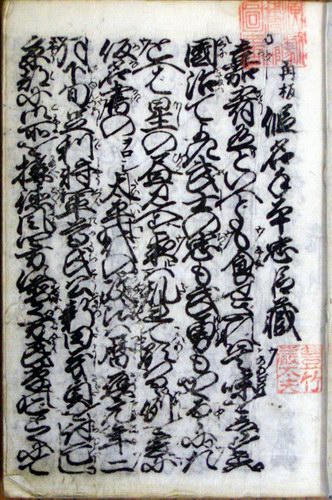 3-A
3-A
Namiki Sôsuke (1695-1751), Takeda Izumo II (1691-1756), and Miyoshi Shôraku (1696?-)
Kanadehon Chûshingura
First performed 1748.08.14, Takemoto Theater, Osaka
Jôruri libretto
Tsubouchi Memorial Theatre Museum ni 10-1110
4. Kanadehon Chûshingura on the Edo Kabuki Stage
Kabuki theaters were already in the habit of borrowing plays from the puppet theater, and they wasted little time in appropriating that Kanadehon Chûshingura. From late 1748 into early 1749, kabuki versions were staged successively in Osaka, Edo, and Kyoto, followed by a summer of intense competition as two of the leading theaters in Edo put on their own renditions of the play, the Ichimura Theater in the fifth month, then the Nakamura Theater the following month.
These seminal early kabuki productions in Edo are documented in a number of surviving prints, of which the example from the Waseda Theatre Museum (4-A, displayed in photographic reproduction, since the original is too fragile to travel) is particularly interesting. The title of the print along the right-hand margin mentions “two theaters,” which must refer to the competition of the Ichimura and Nakamura Theaters. The print is executed in the distinctive style known as “uki-e” (pictures in which objects “float,” or pop out from the surface) that used Western linear perspective, which was brought to Japan by way of China, to create dramatic effects.
In this very early pictorial rendition of the play, we can see two key details already in place, the zigzag pattern on the jackets of the rônin, and the use of labels in the kana syllabary to identify them (a connection reflected in the title word “Kanadehon” or “kana copybook,” from the coincidence that the number of avengers exactly matched the 47 letters of the syllabary). The leader Kuranosuke, identified by the kana for “i”, is seen about to strike Kira, cringing among the charcoal bales, with his dagger. It is unclear whether the kabuki stage enactment of the night attack at this time was quite so chaotic.
4-A
Unsigned
“Perspective View of Kanadehon Chûshingura at the Two Theaters”
(‘Kanadehon Chûshingura ryôshibai kyôgen uki-e’)
Thought to depict a performance of Act XI, Kanadehon Chûshingura, at the Nakamura Theater and/or Ichimura Theater, Edo, ca. 1749.05-06.
Photographic reproduction of the original ôôban woodblock print with hand-coloring.
Tsubouchi Memorial Theatre Museum 100-0868
5. The Print Culture of Edo Theater: Bunraku and Kabuki Programs
The bunraku and kabuki theaters both evolved within a thriving culture of woodblock printing, leaving a huge legacy of material that documents countless productions. Particularly important for theater history were the printed programs, or banzuke (“rank lists”) that began in the Genroku period (1688-1704). Professor Torigoe Bunzô of Waseda University has studied such programs closely and estimates that some 10,000 puppet theater programs and as many as 200,000 kabuki programs survive today from the Edo period.
On exhibit here are several types of Edo theater banzuke, beginning with a single-sheet program for a 1763 jôruri puppet performance of Kanadehon Chûshingura (5-A) that lists the chanters for all eleven acts to the lower left, followed by the samisen players; above is a picture of the famous letter-reading scene from Act VII (see 17-A and 17-B). Item 5-B is the most straightforward type of kabuki program, known as a yakuwari-banzuke (“listing of the roles”) consisting of three sheets (six pages). The opening page of the 1787 example displayed here shows the crest and name of the Kiri Theater in the center, surrounded by the crests and names of the leading actors for this performance. (The mimasu crest of three nested squares of the Ichikawa family appears fully six times.) These continue on the follow page (descending in rank), followed by two pages listing the eleven acts, and two more pages with a complete listing of all the actors in much smaller print.
 5-A
5-A
Puppet theater program for Kanadehon Chûshingura
Performed 1763.01, Takeda Theater, Edo
Tsubouchi Memorial Theatre Museum ni 24-95-1
5-B
Kabuki actor program for Kanadehon Chûshingura
Performed 1787.08, Kiri Theater, Edo
Tsubouchi Memorial Theatre Museum ro 24-1-138
6. Picture Programs (e-banzuke)
The most appealing theater publications were the e-banzuke “picture-programs,” of which three examples are shown here. The earliest one (6-A), for the Ichimura Theater, dates from the memorable summer of 1749 when Kanadehon Chûshingura made its first great sensation in Edo. The program is here open to the pages showing scenes from Acts VII and IX, starting on the left with the celebrated letter-reading scene in the Ichiriki Teahouse. The script gives hints of the plot, while the actors are identified by crests that would be familiar to kabuki fans.
The other two picture-programs are from four to five decades later, from which we can see how the style has changed. Item 6-B shows the cover of a typical picture-program, here for the Miyako Theater in 1795, showing the theater crest and title “Kanadehon Chûshingura” in the center against a background of a curtain with cherry blossoms. The other example (6-C) is a two-page spread from a 1787 picture-program at the Kiri Theater showing the scene in Act IX in which Ôboshi Rikiya stabs Kakogawa Honzô with his lance, as the blood spurts forth. In contrast to the picture program of 1749, the entire composition is far more unified as a picture, with all textual explanation eliminated except for the inscribed names of the actors (now in addition to their crests).
One particularly interesting type of kabuki-related publication was known as “ômuseki,” which took advantage of the improvisational nature of kabuki, where the lines in key scenes were varied from performance to performance. Even with a jôruri-derived play like Kanadehon Chûshingura, in which efforts were made to be roughly faithful to the original text, lines were constantly changed and elaborated on by different actors, particularly for moments of high drama. The word ômuseki (“parrot rock”) refers to rock faces that echo back the voice, and was extended to these printed works that enabled fans to “parrot” their idols. The fad for imitating the distinctive “voice color” (kowairo) of individual actors began in Edo in the 1770s and flourished thereafter. Unlike the formal artistic practices that required a licensed teacher, this was a casual hobby that anyone could try out. Displayed here are two (7-A and 7-B) ômuseki from near the end of the Edo period, revealing a quality of printing that was a quantum leap above the cheap and quick production of ordinary theater programs. The covers were printed in full color, designed by leading artists of actor prints, and the text inside was carefully laid out and carved. These were clearly books to keep, not one-shot programs. The ômuseki, as seen here, consisted simply of a series of separate passages from the current play, with the name of the role in smaller script above, and the actor’s name written larger below―an appropriate indication of which was more important.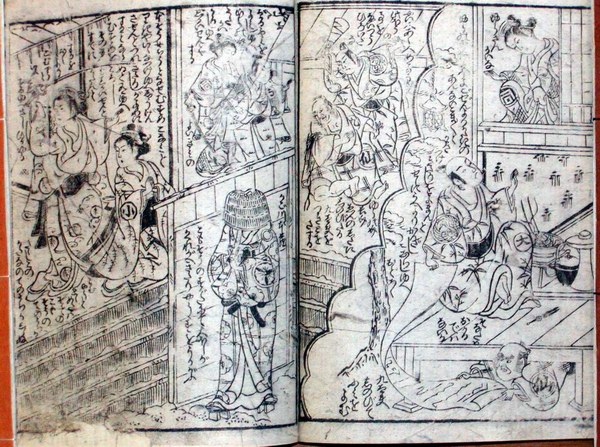 6-A
6-A
Illustrated kabuki program (e-banzuke) for Kanadehon Chûshingura
Performed 1749.05, Ichimura Theater, Edo
Tsubouchi Memorial Theatre Museum i 11-805
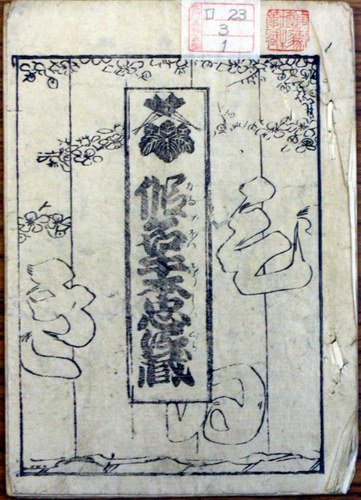 6-B
6-B
Illustrated kabuki program (e-banzuke) for Kanadehon Chûshingura
Performed 1795, Miyako Theater, Edo
Tsubouchi Memorial Theatre Museum ro 23-3-1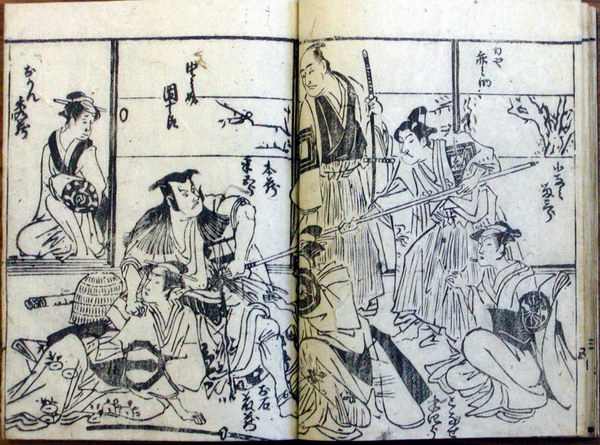 6-C
6-C
Illustrated kabuki program (e-banzuke) for Kanadehon Chûshingura
Performed 1787.08, Kiri Theater, Edo
Tsubouchi Memorial Theatre Museum ro 23-1-90
7. “Parrot Books” for Mimicking Famous Lines
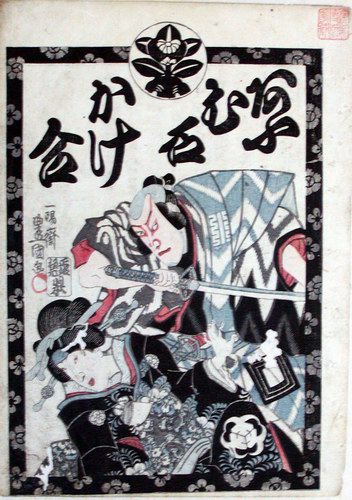 7-A (COVER) (TEXT)
7-A (COVER) (TEXT)
Ômuseki (“parrot book”) for Kanadehon Chûshingura
Performed 1851, Ichimura Theater, Edo
2 vols; covers by Utagawa Toyokuni III [Kunisada] (1786-1864)
Tsubouchi Memorial Theatre Museum ro 6-4-14~15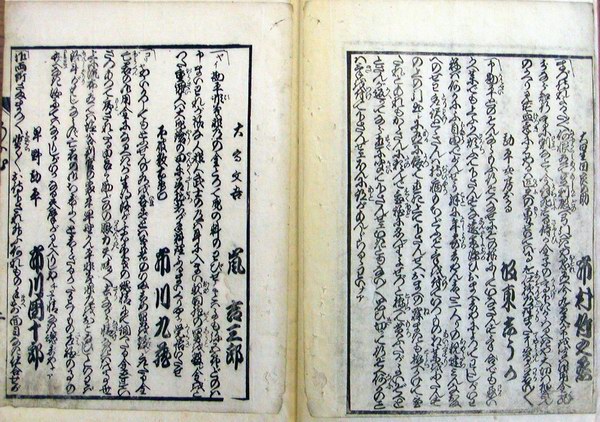
 7-B (COVER) (TEXT)
7-B (COVER) (TEXT)
Ômuseki (“parrot book”) for Kanadehon Chûshingura
Performed 1862, Edo
3 vols; covers by Utagawa Kunihisa (1832-91)
Tsubouchi Memorial Theatre Museum ro 6-5-169~171
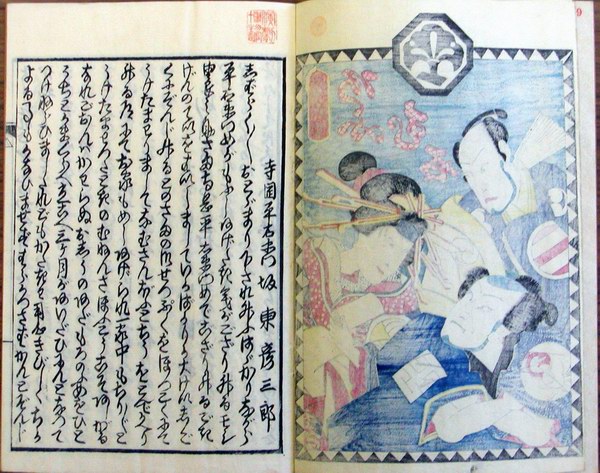
8. Kokon iroha hyôrin: Chronicling Kanadehon Chûshingura
After its initial popularity on the kabuki stage in 1749, Kanadehon Chûshingura continued to be performed regularly in the three major cities of Edo, Kyoto, and Osaka, as well as in provincial venues. As the years passed, a body of lore and criticism about the play accumulated, particularly about the ways in which specific actors performed different roles.
One revealing indication of this body of connoisseurship is the book displayed here (8-A), published in Kyoto in 1785 and entitled Kokon iroha hyôrin or “Collection of Reviews of Chûshingura, Past and Present” (the word “iroha” referring to the associations of the 47 Rônin with the kana syllabary). The page shown to the right is the end of the introduction, signed by the compiler, “Hachimonsha Jishô,” who was in fact Jishô III (1738-?), the grandson of the famous Kyoto publisher Hachimonjiya. He explains that 38 years have now passed since the first kabuki performances of the play in 1749, and that during this period it was staged 41 times in the large theaters of the three major cities (10 each for Kyoto and Osaka, and 21 for Edo)―an average of just over once a year.
To the left is the beginning of several pages of a table providing detailed information about each performance, much of which is not available anywhere else. This page begins with Kyoto performances, each listed in a different row with the vertical columns showing which actors played each of 26 roles. Succeeding pages offer critical evaluations of performances by individual actors.
8-A
Kokon iroha hyôrin
Printed book, 1785
Tsubouchi Memorial Theatre Museum ro 11-103
9. Act I: The Grand Prelude
The first act of puppet plays on historical themes (jidaimono) was known as the “Daijo,” or ‘grand prelude.’ As codified by Chikamatsu Monzaemon, the Daijo was required to be ceremonious and felicitous in tone. These Daijo openings for historical plays were taken over into kabuki, but only in Kanadehon Chûshingura has it been carried over into modern times as an essential part of any full production of the play. This reflects not only the general faithfulness of the kabuki version to its jôruri roots, but also the importance of the Daijo in Chûshingura in establishing the grand theme of revenge, necessitated by the insulting attempt of the villain Kô no Moranao (here as always dressed in black) to seduce Lady Kaoyo, the wife of Enya Hangan.
The Daijo is performed in a grand setting in front of the steps leading up to the vermillion halls of Tsurugaoka Hachiman Shrine in Kamakura, with a giant camphor tree to the left. In keeping with the solemn and ceremonious character of the Daijo, the high-ranking male characters wear voluminous robes with wide sleeves known as daimon (“large crests”) after the oversize family crests of the sort we see we see here both in the print (9-B) and stage photograph (9-A) on Moranao, representing a paulownia leaf and blossom. In the print, Moronao heaps scorn on Wakasanosuke, whose hand reaches for his sword in defense of his honor.
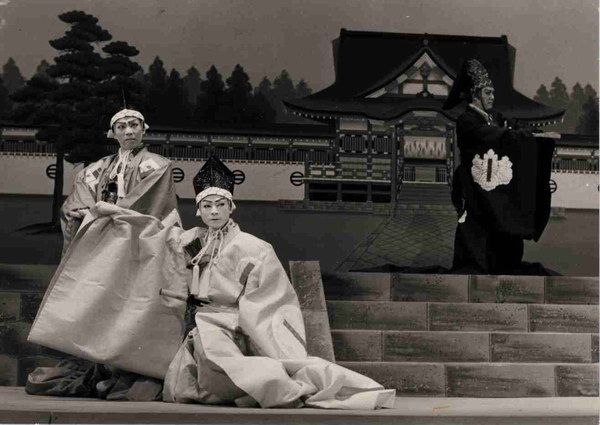 9-A
9-A
At Hachiman Shrine in Kamakura
Act I, Kanadehon Chûshingura
Ichikawa Omezô V as Moronao (R)
Nakamura Fukusuke VIII as Enya Hangan (M)
Onoe Tatsunosuke I as Wakasanosuke (L)
Shin Kabukiza, Tokyo, March 1972
Monochrome photograph
Tsubouchi Memorial Theatre Museum F51-01323
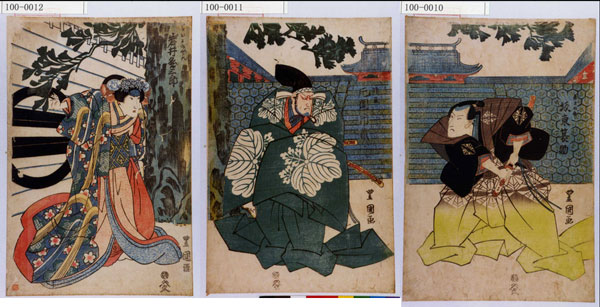 9-B
9-B
Utagawa Toyokuni II (1802-35)
Moronao Taunts Wakasanosuke at Hachiman Shrine
Act I, Kanadehon Chûshingura
Bandô Minosuke II (1802-63) as Wakasanosuke (R)
Kataoka Ichizô I (1792-1862) as Moronao (M)
Iwai Kumezaburô II (1799-1836) as Kaoyo (L)
Performed 1830.04, Ichimura Theater, Edo
Ôban nishiki-e triptych, publ. Yamamotoya Heikichi
Tsubouchi Memorial Theatre Museum 100-0010-12
10. Kanadehon Chûshingura in Color Woodblock Prints
The most impressive legacy of Kanadehon Chûshingura in print is the large number of color woodblock prints that were made primarily to advertise upcoming performances by showing the major actors in well-known scenes, but which also extended into a variety of peripheral genres as well. In general, only a limited number of dramatic high points were selected for illustration, so that the same scenes were depicted over and over. This part of the exhibition moves through Kanadehon Chûshingura act by act, skipping only Act II, which is considered inferior and is rarely performed, and Act VIII, which is a michiyuki travel scene in the original jôruri text, but which was replaced in kabuki after 1833 with a completely different michiyuki performed after Act III.
Many kabuki prints, particularly those of the nineteenth century that account for most of the ones on display here, were issued in multiples of two (diptychs) and three (triptychs). This was a general tendency in late Edo prints, and was done in part to overcome the size limitations of the printing blocks, which could not exceed the normal dimensions of the wild cherry tree from which they were made. The multi-sheet formats also offered the possibility, however, of enjoying each single sheet separately. Many of these works can thus be visually apprehended in two different ways, either as a multi-sheet unit showing actors interacting with one another, or as single portraits of specific actors.
The majority of kabuki prints depicting Kanadehon Chûshingura were intended for a specific performance, which can be identified by the crests of the actors playing particular roles. They served in this way as both advertisements and documents of one-time performances, and were rarely reprinted, so that the total number of any one print probably ran from one hundred to several hundred copies.
The total variety of different Chûshingura prints, however, was very large, particularly if we include the many plays that were derivative of Kanadehon Chûshingura, a category known as kakikae, or “re-writes.” In addition, some prints depicted not a particular performance, but a generic Chûshingura scene, sometimes with specific actors, sometimes not even related to the kabuki stage but rather illustrating the jôruri narrative. Of a total of some 800 Chûshingura-related prints in the Tsubouchi Memorial Theatre Museum at Waseda, 45 percent show specific performances of Kanadehon Chûshingura, 18 per cent depict kakikae performances, and 37 percent are of a generic or miscellaneous type.
The total number of different Chûshingura prints ever issued was long thought to be in the range of 1500-2000, but in the preparation of a complete catalog of such prints that is soon to be published by Akô City, it has been discovered that the actual number is closer to 5000, constituting a huge body of visual material on this single play and its many spin-offs.
In this exhibition, the artist who appears with by far the greatest frequency is Utagawa Kunisada (1786-1864), who used the name “Toyokuni III” after 1844. He accounts for one-third of the prints shown here, followed by his fellow Utagawa school contemporary Kuniyoshi (1797-1861), with half as many. All the rest are by scattered different artists.
11. Act III: The Palace Attack
The historical event that started the entire Chûshingura phenomenon occurred in Edo Castle in the spring of 1701, when Asano Naganori attacked and wounded Kira Yoshinaka. For the crimes of unsheathing his sword in the shogun's palace and disrupting the reception of an imperial delegation from Kyoto, Asano was ordered to perform seppuku, in effect a form of honorable execution. The reliable historical records give no clear indication of the reasons for Asano’s anger, although it was widely rumored that Kira had insulted him for failing to provide adequate gifts in return for ceremonial guidance. History offers little support, however, for the view that had clearly been established by the time of Kanadehon Chûshingura, that Asano was a paragon of samurai virtue who was sent to his death by the evil and greedy Kira. The major contribution of Chûshingura was to replace greed with lust as the primary vice of the villain Moronao.
In the diptych to the left (11-A), we see Moranao making an insulting harangue against Enya Hangan after he has read a letter (in the form of the rolled-up scroll in his left hand) from Hangan’s wife Kaoyo that subtly spurned Moronao’s advances. The triptych (11-C) shows the next instant, as Enya Hangan reaches for his sword to strike Kira, after which he would be restrained from completing his goal by Kakogawa Honzô, who listens in from the right.
11-A
Utagawa Toyokuni III [Kunisada] (1786-1864)
Moronao and Enya Hangan Confront Each Other
Act III, Kanadehon Chûshingura:
Ichikawa Kodanji IV (1812-66) as Moronao (R)
Sawamura Tosshô II (1838-86) as Enya Hangan (L)
Performed 1859.09, Ichimura Theater, Edo
Ôban nishiki-e diptych, publ. Ebiya Rinnosuke
Tsubouchi Memorial Theatre Museum 100-0210/0207
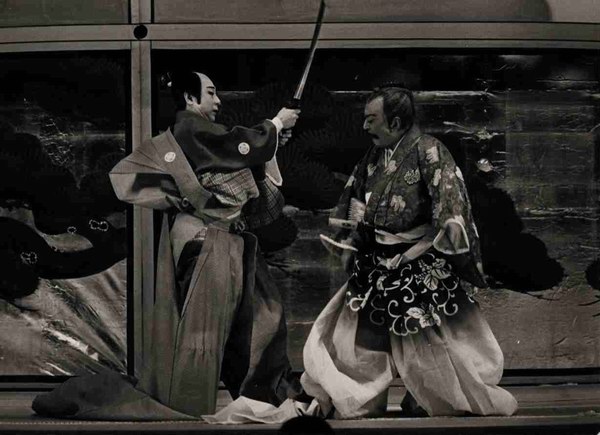 11-B
11-B
Enya Hangan Attacks Kô no Moronao
Act III, Kanadehon Chûshingura
Bandô Mitsugorô VIII as Moronao (R)
Onoe Baikô VII as Enya Hangan (L)
Kabukiza, Tokyo, November 1968
Monochrome photograph
Tsubouchi Memorial Theatre Museum F51-01542
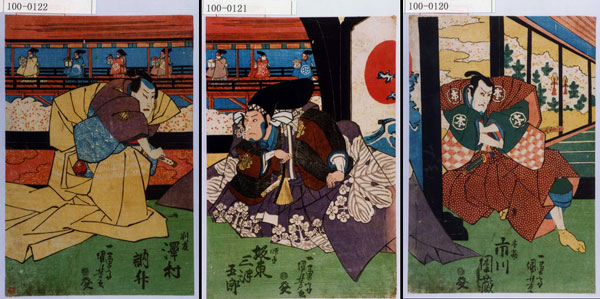 11-C
11-CUtagawa Kuniyoshi (1797-1861)
Enya Hangan Attacks Moronao as Honzô Watches
Act III, Kanadehon Chûshingura
Ichikawa Danzô V (1788-1845) as Honzô (R)
Bandô Mitsugorô IV (1802-63) as Moronao (M)
Sawamura Tosshô I (1802-63) as Enya Hangan (L)
Performed 1835.08, Morita Theater, Edo
Ôban nishiki-e triptych, publ.Yamamotoya Heikichi
Tsubouchi Memorial Theatre Museum 100-0120-22
12. Michiyuki: The Dance Interlude
A michiyuki (literally ‘travel-going’) is a short interlude that stylistically depicts the journey of one or more characters to a particular location. In the narrated text of puppet plays, the michiyuki usually serves to recount the history and poetic associations attributed to famous sites, thereby connecting the play to both the physical world and to literary tradition. In kabuki plays, on the other hand, michiyuki consist primarily of song and dance. After the michiyuki form in jôruri was perfected by Chikamatsu Monzaemon, its became a near obligatory component of every play, both puppet and kabuki.
In the puppet play Kanadehon Chûshingura, Act VIII is the michiyuki, but in Edo kabuki, a totally new michiyuki was devised in 1833 for the Kawarazaki Theater, placed after Act III and showing the two lovers, Kanpei and Okaru, leaving the capital for Okaru’s country home. While much of the original text remained the same, three dances and two fight sequences were added, successfully transforming it into a visual spectacle unmatched in the rest of the play. It quickly became a standard part of any kabuki production of Kanadehon Chûshingura, although it is now usually performed after Act IV (out of order for the story, but better timing when Act II is cut).
As seen in the diptych 12-A, the michiyuki is often performed with the chanters and musicians in full view on the stage rather than in a box above to the side. The other diptych (12-B) shows the stylish lovers Kanpei and Okaru confronting the clown-like Bannai and his servant Bekunai in a stylized fight scene.
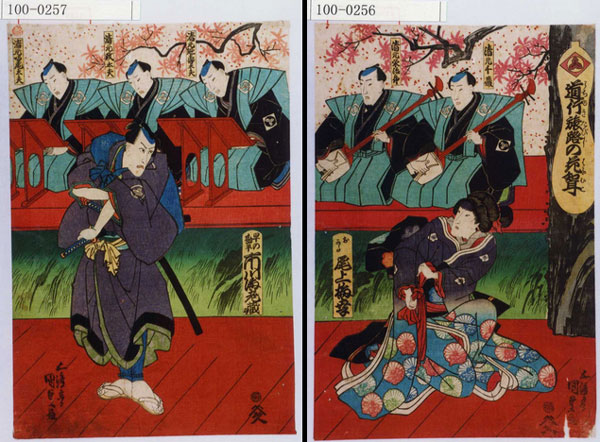 12-A
12-A
Utagawa Kunisada (1786-1864)
Michiyuki Journey of Kanpei and Okaru with Kiyomoto Chorus
Michiyuki, Kanadehon Chushingura
Onoe Baikô III (1784-1849) as Okaru (R)
Ichikawa Ebizô V (1791-1859) as Kanpei (L)
Performed 1833.03, Kawarazaki Theater, Edo
Ôban nishiki-e diptych, publ.Yamamotoya Heikichi
Tsubouchi Memorial Theatre Museum 100-0256-57
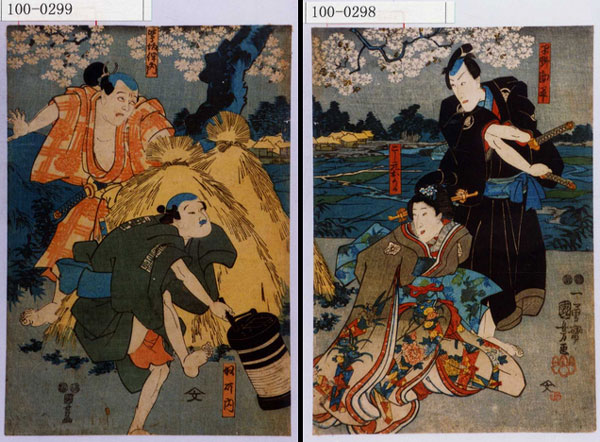 12-B
12-B
Utagawa Kuniyoshi (1797-1861)
Kanpei and Okaru Encounter Sagisaka Bannai and Yakko Bekunai
Michiyuki, Kanadehon Chûshingura
Ichikawa Danjûrô VIII (1823-54) as Kanpei (R)
Bandô Shûka I (1813-55) as Okaru (R)
Ichikawa Komazô VI as Bannai (L)
Nakayama Bungorô II (?-1862) as Yakko Bekunai (L)
Performed 1851, Ichimura Theater, Edo
Ôban nishiki-e diptych, publ. Tsujiokaya Bunsuke
Tsubouchi Memorial Theatre Museum 100-0298-99
13. Act IV: The Seppuku Of Enya Hangan
Enya Hangan, confined to his residence after attacking Moronao, has been sentenced to seppuku. In both prints here, the Asano family crest of crossed feathers lines the walls behind. In the play, Hangan asks whether his trust chief retainer Ôboshi Yuranosuke has yet arrived; twice being told no, he plunges his dagger into his abdomen―at which moment Yuranosuke enters on the hanamichi from the left, too late for the moment of decision but still in time to speak with his dying lord.
This timing is overlooked in the diptych by Kunisada (13-A), which focuses rather on the mental attitude of each of the men, Hangan gripping his dagger in his resolve to die as his hand reaches to pull back his outer garment and reveal the pale blue death robes beneath (as seen in the stage photograph). Yuranosuke bends low in deference to his lord, his face filled with concern and affection. This is a good example of a diptych in which each half works better alone than the two together, and presumably each could have been purchased separately.
The seppuku of Enya Hangan is always a high point in any performance of Kanadehon Chûshingura, as the audience watches in total silence. Just before he at last expires, Hangan declares “I leave you this dagger as a memento of me. Avenge me!” Yuranosuke then gently pries the dagger from the grip of his dead master, and holds it up to vow revenge.
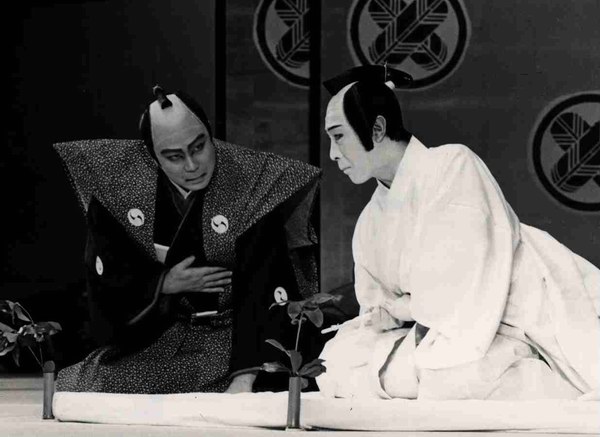 13-A
13-A Yuranosuke at the Seppuku of Enya Hangan
Act IV, Kanadehon Chûshingura
Onoe Kikugorô VII as Enya Hangan
Nakamura Kichiemon II as Ôboshi Yuranosuke
Kabukiza, Tokyo, December 1, 1983
Monochrome photograph
Tsubouchi Memorial Theatre Museum F51-01712
 13-B
13-BUtagawa Kunisada (1786-1864)
Yuranosuke Arrives Late for the Seppuku of Enya Hangan
Act IV, Kanadehon Chûshingura:
Seki Sanjûrô II (1786-1839) as Enya Hangan (R)
Bandô Mitsugorô III (1775-1832) as Ôboshi Yuranosuke (L)
Performed 1830.04, Ichimura Theater, Edo
Ôban nishiki-e diptych, publ. Ômiya Heihachi
Tsubouchi Memorial Theatre Museum 100-0306-07
14. Trick Pictures (Shikake-e)
This diptych (14-A) is a characteristic print of the Meiji period, both in the distinctive facial types and in the strong, heavy colors. The dark blues and reds are probably the new chemical pigments that were introduced from the West in the 1860s and came to typify prints in the era of “civilization and enlightenment” in the 1870s.
The most unusual feature of this print, however, is that it is a type of “trick picture” (shikake-e), devised to reflect the unusual casting of this particular performance at the Shintomi Theater, with the leading roles being rotated each day among different actors. The device seems to have been very popular, and this print was probably a way to advertise it, using the technique known as komochi-e (“prints with children”). The face of each actor is in fact a stack of separate faces that can be flipped up like a calendar, each showing a different actor, for a total of five for each role. The stack of four mini-prints is attached to the main print with thread. The names of the actors who performed each role (of which four played both) are listed on the image of a handscroll in the top center.
In studying the details of the separate portraits for the different actors, there seems at first glance little to distinguish one from the other. Looking more closely, however, you can observe many subtle differences, particularly in the shape of the mouth, the position of the eyes, and the contours of the eyebrows. Like all ukiyo-e actor prints, these works bring us to contemplate the differences and the overlap between an actor and his role.
 14-A
14-A
Toyohara Chikayoshi (fl. 1870s-80s)
Yuranosuke Arrives Late for the Seppuku of Enya Hangan
Act IV, Kanadehon Chûshingura
As Enya Hangan (R), in layers from top: Onoe Kikugorô V (1844-1903), Ichimura Kakitsu V (1847-1893), Ichikawa Sadanji I (1842-1904),Nakamura Sôjurô I (1835-1889), Ichikawa Danjurô IX (1838-1903)
As Ôboshi Yuranosuke (L), in layers from top: Ichikawa Danjurô IX (1838-1903), Onoe Kikugorô V (1844-1903), Ichikawa Sadanji I (1842-1904), Nakamura Nakazô III (1809-1886), Nakamura Sôjurô I (1835-1889)
Performed November, 1878, Shintomi Theater, Tokyo
Ôban nishiki-e diptych, publ. Fukuda Kumajirô
Tsubouchi Memorial Theatre Museum 100-0335-36
15. Act V: Robbery and Murder on the Yamazaki Highway
Kanpei has returned to his wife Okaru’s home in Yamazaki, eking out a meager existence in hiding, hoping to muster the money and credibility to become a samurai again and join the would-be avengers. At the same time, Ono Sadakurô, an Enya retainer who has betrayed his calling to become a highwayman, robs and kills an old man―who turns out to be Kanpei’s father-in-law Yoichibei. Unable to see much of anything in the dark, Kanpei fires his hunting musket at what he thinks is a wild boar, and kills the thief Sadakurô. He takes the purse from the dead man, which will lead him to believe he killed his father-in-law, and to take his own life in the following act.
The four different prints here range over a period of more than five decades, and reveal an evolution from the plain but stylish Shun’ei print of Bandô Mitsugorô II as Kanpei in 1795 (15-A), with minimal background and primary concern for the presence of the actor, to the increasingly busy and dramatic works of 1805 (15-B) and 1819 (15-D), on to the positively baroque composition of Kuniyoshi in 1849 (15-E).
The role of Sadakurô, as seen here in both a print (15-B) and recent stage photo (15-A), was made famous by Nakamura Nakazô I in 1766, by eliminating all the spoken lines and acting purely in mime―wonderfully epitomized by placing the stolen purse in his mouth. Another sort of performance tour de force is seen in 6-D, where Ichikawa Danjurô plays two different roles in one scene with the “quick-change” (hayagawari) technique that audiences love.
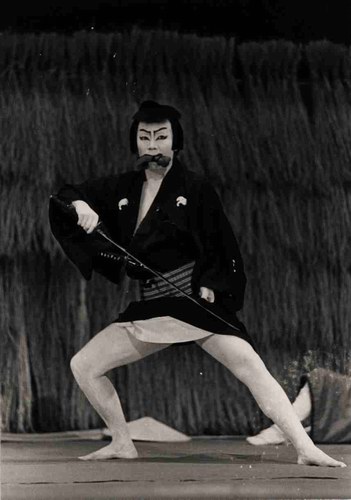 15-A
15-A
Ono Sadakurô with Yoichibei’s Purse in His Mouth
Act V, Kanadehon Chûshingura
Onoe Tatsunosuke I as Ono Sadakurô
Kabukiza, Tokyo, February 1973
Monochrome photograph
Tsubouchi Memorial Theatre Museum F51-02137
15-B
Katsukawa Shun’ei (1762-1819)
Kanpei on the Yamazaki Highway
Act V, Kanadehon Chûshingura
Bandô Mitsugorô II (1741-1828) as Kanpei
Performed 1795.04, Miyako Theater, Edo
Hosoban nishiki-e
Tsubouchi Memorial Theatre Museum 100-0440
15-C
Utagawa Toyokuni (1769-1825)
Sadakurô Steals Yoichibei’s Purse
Act V, Kanadehon Chûshingura
Ichikawa Omezô I (1781-1833) as Ono Sadakurô
Performed 1805.06.10, Kawarazaki Theater, Edo
Ôban nishiki-e, publ. Shimizu
Tsubouchi Memorial Theatre Museum 100-0390
15-D
Utagawa Kunisada (1786-1864)
Ichikawa Danjûrô VII as Both Kanpei and Sadakurô
Act V, Kanadehon Chûshingura
Ichikawa Danjûrô VII (1791-1859) as both Ono Sadakurô (R) and Hayano Kanpei (L) (two of seven quick-change roles)
Performed 1819.04i, Tamagawa Theater, Edo
Ôban nishiki-e diptych, publ. Uemura Yohei
Tsubouchi Memorial Theatre Museum 100-0435-36
15-E
Utagawa Kuniyoshi (1797-1861)
Kanpei Shoots Sadakurô
Act V, Kanadehon Chûshingura
Ichikawa Kuzô II as Ono Sadakurô (R)
Sawamura Chôjûrô V (1802-53) as Hayano Kanpei (L)
Performed 1849.07, Nakamura Theater, Edo
Ôban nishiki-e diptych, publ. Enshûya Hikobei
Tsubouchi Memorial Theatre Museum 100-0402-03
16. Act VI: The Tragedy of Kanpei
Kanpei is a figure of continuing misfortune from Act III until his demise in Act VI. First appearing as a handsome man deeply in love with his wife/lover Okaru, he first pays the price by dallying with her while his master Hangan makes the fatal mistake of striking Kira. In Acts V, as we have seen, he takes the purse of his slain father-in-law thinking that it was a gift from the gods, when in fact it was money obtained by selling his own wife into prostitution. In Act VI, Kanpei’s fall from grace continues. Led to believe that he has in fact killed his father-in-law, he takes his life.Kanpei first appears in Act VI on his return home from his nighttime adventure in Act V, filled with hope that the money in the purse taken from Sadakurô’s body will gain him entry to the league. In this triptych (16-A), he discovers as he enters the gate that Okaru is being taken off to the Gion pleasure quarter in Kyoto by the brothel owner Ichimonjiya (on the right), and he defiantly stops the palanquin with his raised hand. As the Act progresses through complex plot twists, Kanpei is led to believe that the man he killed was his own father-in-law, and he takes his dagger to his abdomen in a drawn-out act of self-inflicted seppuku―far more painful and bloody than that of Enya Hangan in Act IV. As we see here in Kunisada’s dramatic print, his body is marked by bloody handprints where he seems to have struck himself in mortification.
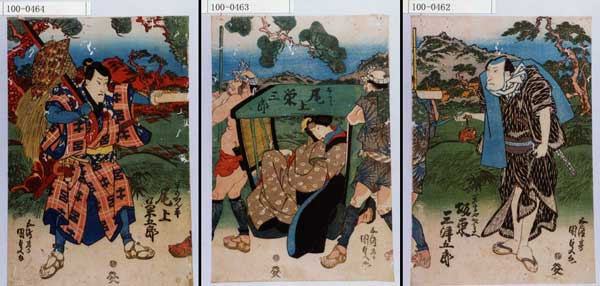 16-A
16-A
Utagawa Kunisada (1786-1864)
Kanpei Stops Ichimonjiya from Taking Okaru Away
Act VI, Kanadehon Chûshingura
Bandô Mitsugorô IV (1802-63) as Ichimonjiya (R)
Onoe Eizaburô III (1808-61) as Okaru (M)
Onoe Kikugorô III (1784-1849) as Kanpei (L)
Performed 1833.08, Ichimura Theater, Edo
Ôban nishiki-e triptych, publ. Yamamotoya Heikichi
Tsubouchi Memorial Theatre Museum 100-0462-64
16-B
Utagawa Toyokuni III [Kunisada] (1786-1864)
Kanpei Commits Harakiri Only to Learn of His Error
Act VI, Kanadehon Chushingura
Nakamura Fukusuke (1830-99) as Kanpei
Performed 1860.04, Nakamura Theater, Edo
Photographic reproduction of ôban nishiki-e, publ. Tsujiya Yasubei
Tsubouchi Memorial Theatre Museum 100-0495
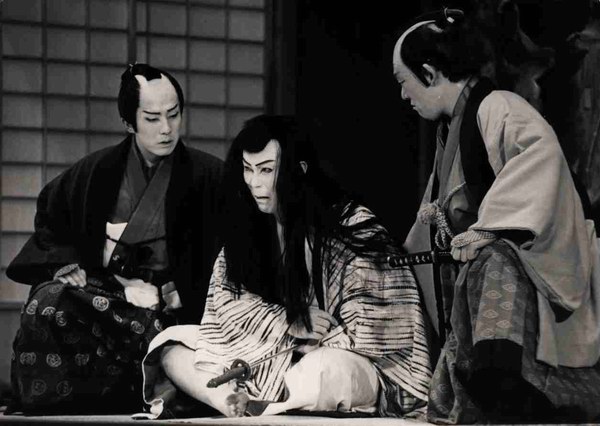 16-C
16-C
The Seppuku of Kanpei
Act VI, Kanadehon Chûshingura
Nakamura Kankurô as Senzaki Yagorô
Nakamura Kichiemon II as Hayano Kanpei Ichikawa Sadanji IV as Fuwa Kazuemon
Kabukiza, Tokyo, March 1980
Monochrome photograph
Tsubouchi Memorial Theatre Museum F51-02335
17. Act VII: Reading the Letter and Descending the Ladder
Act VII is the most popular of all the eleven acts of Kanadehon Chûshingura for a variety of reasons, among them the colorful setting of the Ichiriki teahouse and the complex psychological depiction of Yuranosuke, who must at once convince the spies of Moranao that he has no interest in revenge, and at the same time persuade his fellow rônin of his dedication to precisely that goal. But it is also the wide assortment of witty stage devices used in this act that make it a perennial favorite.
Shown here are two of the best-known such moments. Particularly geared to pictorial depiction is the scene in which Yuranosuke tries furtively to read a letter that has been delivered from his wife Kaoyo, reporting on the enemy’s situation. Unknown to him, Kanpei’s wife Okaru, who is now in service at the teahouse, looks down from a room above and thinks that it must be a love letter. Lonely, she wishes to read it and uses a mirror for illumination (optically implausible but very effective on the stage). Meanwhile, Moronaro’s spy Kudayû reads the same letter from his hiding place beneath the veranda, as Yuranosuke slowly unrolls it. This famous scene is shown here by Yoshitoshi (17-A) and in a parodic version by Sadatora (17-B) where the characters are replaced by three of the Gods of Fortune.
After Yuranosuke discovers Okaru in the room above, he gallantly helps her down the ladder (17-D, an unusual vertical diptych, and 17-C), making lascivious comments (omitted from early English translations of the play) about what he can see under her kimono.
17-A
Tsukioka Yoshitoshi (1839-1892)
Kudayû Reads the Letter That Yuranosuke Hides from Okaru
Act VII, Kanadehon Chûshingura
Kataoka Nizaemon VIII (1810-63) as Yuranosuke
Sawamura Tanosuke III (1845-78) as Okaru
Asao Yoroku II (1821-62) as Kudayû
Performed 1862.03, Nakamura Theater, Edo
Ôban nishiki-e, publ. Kakumotoya Kinjirô
Tsubouchi Memorial Museum 100-0604
17-B
Utagawa Sadatora (fl. 1820s)
Parody of Chûshingura with the Gods of Good Fortune: Act VII
(‘Mitate fukujin Chûshingura: Shichi-danme’)
Ôban nishiki-e, ca. 1820s, publ. Ezakiya Kichibei
Tsubouchi Memorial Theatre Museum 100-1648
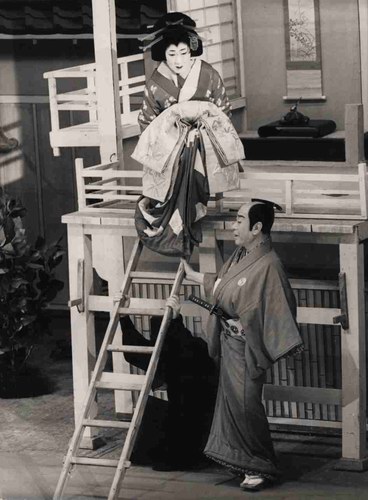 17-C
17-C
Yuranosuke Helps Okaru Down the Ladder
Act VII, Kanadehon Chûshingura
Nakamura Senjaku II as Okaru
Nakamura Ganjirô II as Ôboshi Yuranosuke
Shin Kabukiza, February 1969
Monochrome photograph
Tsubouchi Memorial Theatre Museum F51-02546
17-D
Utagawa Kunisada (1786-1864)
Yuranosuke Helps Okaru Down the Ladder
Act VII, Kanadehon Chûshingura
Iwai Shijaku I (1804-45) as Okaru
Onoe Kikugorô III (1784-1849) as Yuranosuke
Performed 1837.08, Nakamura Theater, Edo
Ôban nishiki-e diptych (vert.), publ.Yamaguchiya Tôbei
Tsubouchi Memorial Theatre Museum 100-0666-67
18. Okaru and Heiemon
Later in Act VII, Okaru is confronted by her brother Heiemon, a retainer of Enya Hangan of lowly ashigaru (footsoldier) rank who has been begging Yuranosuke to let him join to league of revenge. Upon discovering that Okaru has read the letter reporting on Moranao, Heiemon realizes that she must be prevented from revealing the secret of the plans for revenge, and that Yuranosuke will probably try to take her life. He therefore vows to kill her himself, but as he draws his sword, she draws back and tries to distract him with a shower of tissue papers drawn from the breast of her kimono. It is another one of the exciting stage moments that typify Act VII, as shown here (18-A) in a print by Kunichika.
This particular print, which was published in 1897, is a wonderful example of the bright and even garish colors that were in favor in woodblock prints of the Meiji era. The brightest of these were chemical aniline dyes from Europe; they have been much disparaged by connoisseurs of classical ukiyo-e, but in works like this, they work effectively to convey a sense of the color and excitement of the kabuki theater.
Toyohara Kunichika (1835-1900)
Okaru Scatters Paper to Fend Off Heiemon’s Attack
Act VII, Kanadehon Chushingura
Ichikawa Danjûrô IX (1838-1903) as Yuranosuke (R)
Nakamura Fukusuke IV (1866-1940) as Okaru (M)
Onoe Kikugorô V (1844-1903) as Heiemon (L)
Performed June 1897, Kabukiza, Tokyo
Ôban nishiki-e triptych, publ. Akiyama Buemon
Tsubouchi Memorial Theatre Museum 100-0692-94
19. Act IX: The Yamashina Retreat
Act IX is perhaps the most unfairly neglected of the eleven acts of Kanadehon Chûshingura, since it is often dropped in all-day performances (tôshi-kyôgen) of the entire play, simply because the current kabuki schedules do not allow the time for it, even though it is recognized as an important and effective part of the play. It takes place in Ôboshi Yuranosuke’s residence in Yamashina, on the outskirts of Kyoto, and centers on the character Kakogawa Honzô and his wife Tonase and daughter Konami. The two women have come to visit the Ôboshi household to complete arrangements for the betrothal of Konami to Yuranosuke’s son Rikiya―unaware that both father and son are about to depart on their mission of revenge.
In the dramatic scene shown in this Kunisada triptych of 1837 (19-B), we see Tonase preparing to take the life of her daughter Konami after her offer of marriage has been spurned by Yuranosuke’s wife O-Ishi, who stands to the right holding a wooden stand for which she will later demand the head of Honzô. As Konami raises her sword to strike off Konami’s head, however, she hears the flute of a mendicant priest outside the gate (who is really Honzô in disguise, as clearly labeled on the print) and a sudden voice “Stop!” She hesitates and moves to strike again, but the fluter and voice repeat. As she raises her sword a third time, she is stopped by O-Ishi, who has been observing from the side and was moved by the resolve of both mother and daughter.
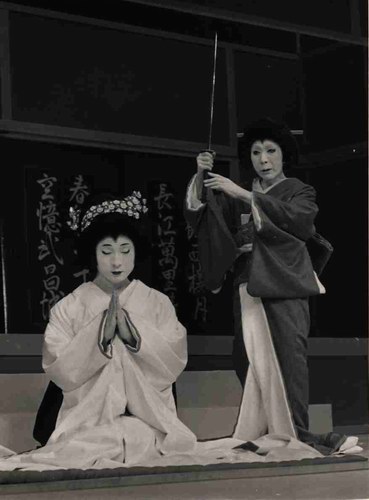 19-A
19-A
Tonase Prepares to Kill Her Daughter Konami
Act IX, Kanadehon Chûshingura
Nakamura Utaemon VI as Tonase
Nakamura Matsue V as Konami
National Theatre, Tokyo, December 1974
Monochrome photograph
Tsubouchi Memorial Theatre Museum F51-02777
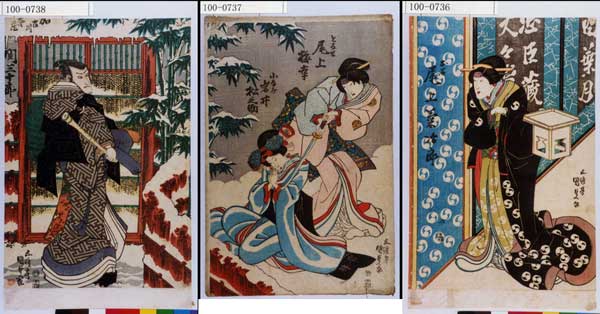 19-B
19-B
Utagawa Kunisada (1786-1864)
TonasePrepares to Kill Konami as O-Ishi Looks on and Honzô Appears at the Gate as a Wandering Monk with Flute
Act IX, Kanadehon Chûshingura
Onoe Kikujurô II (d. 1875) as O-Ishi (R)
Onoe Baikô III (1784-1859) as Tonase (M)
Iwai Matsunosuke II (dates unknown) as Konami (M)
Seki Sanjûrô II (1786-1839) as Kakogawa Honzô (L)
Performed 1837.08, Nakamura Theater, Edo
Ôban nishiki-e triptych, publ. Kagaya Kichiemon
Tsubouchi Memorial Theatre Museum 100-0736-38
20. Act X: The Faithful Merchant Gihei
Act X of Kanadehon Chûshingura is rarely performed today, both because of its somewhat clumsy story line, and because the episode that it tells, of the “faithful merchant” Amakawaya Gihei, is not central to the overall story of the revenge against Moronao. Nevertheless, the character of Gihei was well known in the Edo period, above all for the one scene depicted here (20-A) in which he defiantly protects a chest of weapons that he has procured for the league members from government police who accuse him of conspiracy with the rônin. Not realizing that the “police” are some of the rônin who wish to test his loyalty, he valiantly leaps on top of the chest and declares his famous line of defiance, “Gihei of Amakawaya is a true man!” (Amakawaya no Gihei wa otoko de gozaru zo). It is a model case of a merchant who aspires to act like a samurai.
The other item on display here (20-B) also shows the defiant Gihei as he is threatened by the “police,” but it is mostly notable as a very rare example of a preliminary sketch for a color woodblock print that was never actually produced. It is signed at the end by Kunisada, and mounted as a handscroll together with designs for nine other acts of the play. It provides a rare opportunity to see the direct hand of the leading artist of Chûshingura theater prints
20-A
Utagawa Kunisada (1786-1864)
Gihei Defends the Chest of Armor
Act X, Kanadehon Chûshingura
Ichikawa Ebizô V (1791-1859) as Amakawaya Gihei
Performed 1833.03, Kawarazaki Theater, Edo
Ôban nishiki-e, publ.Yamamotoya Heikichi
Tsubouchi Memorial Theatre Museum 100-0834
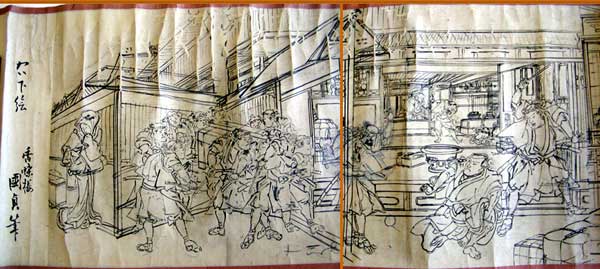 20-B
20-B
Utagawa Kunisada (1786-1864)
Act X, Kanadehon Chûshingura
One of ten preliminary sketches for series of ôban triptychs depicting Acts I-X of Kanadehon Chûshingura.
Signed at end “Kôchôrô Kunisada hitsu”
Handscroll, ca. 1830s, 37 cm H x 777 cm W
Tsubouchi Memorial Theatre Museum 21
21. Act XI: The Night Attack on Kira’s Mansion
The final act of Kanadehon Chûshingura is much like the “grand prelude” that begins it, colorful and spectacular―although now the atmosphere has changed completely from ominous foreboding to rousing celebration. It presents the culmination of the revenge, the attack on Moranao’s mansion and the taking of his head, mostly as a sequence of swordfight dances. It is on the whole brief, with minimal dialogue and no plot to speak of.
This triptych of 1817 (21-B) is a wonderful example of the work of Toyokuni I, the progenitor of most of the Utagawa school artists who dominated late Edo ukiyo-e. It shows Yuranosuke holding a lantern marked “Loyalty” (Chû) while another rônin confronts Moronao with a spear as he emerges from among the charcoal bales. The scene also reminds us of the importance of costume, both on the kabuki stage and in actor prints like this that depict and celebrate it. Costume was of interest from the very morning on which the Akô retainers marched the seven miles from Kira’s mansion to their master’s grave at Sengakuji, and eyewitness accounts confirm that they wore motley battle dress, heavily protected and giving the impression of fireman’s wear. On the stage, the attackers came to be dressed in matching jackets with the familiar black-and-white zigzag pattern that was itself a kabuki invention. Under the jackets, however, as we see here, the stage attackers are elegantly and colorfully costumed, more ready to party than fight.
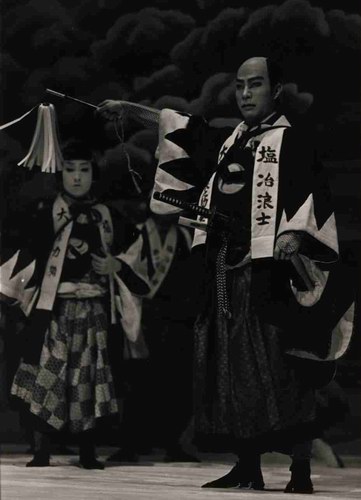 21-A
21-A
Ôboshi Yuranosuke and Rikiya at the Night Attack
Act XI, Kanadehon Chûshingura
Ichikawa Ebizô X as Ôboshi Yuranosuke
Nakamura Senjaku II as Ôboshi Rikiya
Shinbashi Enbujô, March 1972
Monochrome photograph
Tsubouchi Memorial Theatre Museum F51-02848
21-B
Utagawa Toyokuni (1769-1825)
Yuranosuke and Kazuemon Discover Moronao in the Charcoal Shed
Act XI, Kanadehon Chûshingura
Ichikawa Danjurô VII (1791-1859) as Ôboshi Yuranosuke (R)
Matsumoto Kôshirô V (1768-1838) as Kô no Moronao (M)
Bandô Mitsugorô III (1775-1831) as Fuwa Kazuemon (L)
Performed 1817.07.17, Nakamura Theater
Ôban nishiki-e triptych, publ. Matsumura Tatsuemon
Tsubouchi Memorial Theatre Museum 100-0880-82
22. Imagining the Retreat to Sengakuji
In the final decades of the Tokugawa period, encouraged by a wave of popularity for warrior prints (musha-e) from the 1830s, particularly those of Kuniyoshi, there appeared numerous triptychs depicting the revenge of the 47 Rônin in ways that derived more from the historical Akô vendetta than from the kabuki stage. This triptych (22-A) by Kuniyoshi is a fine example of the genre, showing the rônin gathering at the gate of the temple where their master lay buried. The historical Sengakuji is thinly disguised in the title as “Sengokuji,” and the labeled names remain similar to those of the kabuki stage, with the leader seated at the bottom of the middle panel identified as “Ôboshi Yuranosuke.” No such scene appears, however, in the original jôruri―which includes only the opinion of Yuranosuke that “it would be best to end our lives before our master’s tomb,” but never follows them there. Kabuki as well ends only with the group setting out for the temple.
Here we are rather offered an imagined view of the rônin arriving at the temple gate, with a view out over Edo Bay to the left. Their costume is that of the kabuki stage, to be sure, but prints like these worked to recover the historicity of the original Akô Incident, particularly since so many citizens of Edo actually witnessed the march to Sengakuji on that early winter morning.
Utagawa Kuniyoshi (1798-1861)
“Having Achieved Their Goal, the Loyal Retainers Retreat to Sengokuji [sic]”
(Gishi honmô o tasshite Sengokuji e hikitori-katame no zu)
Ôban nishiki-e triptych, publ. 1847-52 by Yorozuya Kichibei
Tsubouchi Memorial Theatre Museum 100-1487-89
23. Combining the Acts: Perspective Prints of Chûshingura
A large category of Chûshingura prints depict not particular kabuki stage performances with identifiable actors, but rather a more generic version in which the characters appeared in a broad landscape setting. Many of these were in the uki-e style that used exaggerated Western perspective for dramatic effect (see 1-E), and were typically issued in sets of eleven, with one sheet for each act. Rather than focusing on a single famous scene in a given act, the prints shown here skillfully combined two or more scenes in one composition, offering a chronological sequence within a single space.
In Masayoshi’s depiction of Act III (23-A), for example, we start to the lower right as a bowing Honzô offers gifts to appease Moronao at the gate of the Ashikaga mansion, while above inside the mansion appears the subsequent scene of Hangan attacking Moronao, while finally to the lower left is the concluding scene of Honzô (now appearing for the second time) fighting off Bannai and his minions. Similarly, in Hokusai’s view of Act X of the same era (23-B), the “faithful merchant” Gihei appears twice, first talking with his wife Osono at the gate in the center, and then at the entrance to his store, the Amakawaya, defending an oddly small armor chest from the attacking “police.” The stylized clouds at the top of both these prints suggests a link to the older tradition of narrative handscrolls, as does the integration of temporal sequence into a single space. Prints like these may well have been based on the jôruri rather than kabuki form of the play.
23-A
Kitao Masayoshi (1764-1824)
“Perspective Views of Kanadehon Chûshingura: Act III”
(‘Uki-eKanadehon Chûshingura: San-danme’)
Generic view (mitate-e), no specific actors or performance.
Ôban nishiki-e, publ. ca. 1790s by Tsuruya Kiemon
Tsubouchi Memorial Theatre Museum 100-0285
23-B
Kakô [Katsushika Hokusai] (1760-1849)
“New Perspective Views of Chûshingura: Act VIII”
(‘Shinpan uki-e Chûshingura: Dai hachi-danme’)
Generic view (mitate-e), no specific actors or performance.
Aiban nishiki-e, publ. ca. 1801 by Iseya Rihei
Tsubouchi Memorial Theatre Museum 100-1463
24. All Eleven Acts in a “Single View”
An even more ambitious sort of attempt to put multiple scenes onto a single sheet can be seen in “single view” (ichiran) prints that combine iconic scenes from each act into a single overall composition. In the triptych by Yoshitora (24-A), the artist has devised a clever composition that moves in an S-shape, from top to bottom in the right sheet, then bottom to top in the middle, and again top to bottom on the left. The separate scenes are separated by fences and walls to create the sense of a naturally continuous space. The inclusion of the Act VIII michiyuki suggests that this represents the jôruri rather than kabuki version (see the descriptive label below for identification of the scenes).
Of a wholly different sort is Hiroshige’s five-sheet “comic parody” of Kanadehon Chûshingura (24-B), which offers 26 vignettes that transpose well-known scenes of the play to the everyday life of street vendors and popular performers. Lady Kaoyo in Act I chooses a pumpkin instead of helmet (sheet 1, top), Sadakurô of Act V buys his trademark tattered umbrella from Yoichibei (sheet 2, bottom left ), Yuranosuke in Act VII selects a piece of octopus from Kudayû as a street vendor (sheet 3, middle left), and the rônin perform acrobatic tricks on the ladder used for the night attack (sheet 5, bottom right). Only those completely familiar with the play would appreciate the ironic humor of these scenes that bring the high drama of Chûshingura down to the level of ordinary life.
24-A
Utagawa Yoshitora (fl. ca. 1850s-1870s)
“A Single View of All Eleven Acts of Kanadehon Chûshingura”
(‘Kanadehon Chûshingura jûichi-dan tsuzuki ichiran no zu’)
Right sheet (from top): Act I (Kaoyo chooses the helmet), Act II (Honzô cuts the pine branch), Act III (Enya Hangan attacks Moronao).
Middle sheet (from bottom): Act IV (Gôemon and Rikiya at Enya Hangan’s mansion), Act. V (Sadakuro kills Yoichibei), Act. VI (Okaru and Kanpei), Act. VII (Okaru and Kudayû read Yuranosuke’s letter), Act VIII (Bridal journey of Konami and Tonase).
Left sheet (from top): Act IX (Honzô tramples the wooden stand), Act X (Gihei defends the armor chest), Act XI (The rônin find Kira in the charcoal shed)
Ôban nishiki-e triptych, publ. 1847-52 by Yamadaya Shôbei
Tsubouchi Memorial Theatre Museum 100-1068-70
24-B
Utagawa Hiroshige (1797-1858)
“A Comic Parody of Chûshingura” (‘Mitate kokkei Chûshingura’)
Ôban nishiki-e pentaptych, publ. ca. 1830s by Yamamotoya Heikichi
Tsubouchi Memorial Theatre Museum 100-1453-57
25. Portraits of the Gishi
The popularity of the 47 Rônin in the late Edo period was promoted as much by legends of the historical Akô avengers as by the theatrical tradition of Kanadehon Chûshingura, a trend stimulated largely by the genre of oral storytelling known as kôdan, which focused less on the overall story of the vendetta than on tales of the individual “Gishi” (‘righteous samurai’). As a result, print series were created offering individual portraits of all 47 samurai, inevitably as they appeared in the night attack. The two sets sampled here bear the identical title of Seichû gishinden, “Lives of the Righteous and Loyal Retainers,” but they are very different in most other respects.
Kuniyoshi’s version (25-A, 25-B) dates from 1847-48, when it was still forbidden to use the real names of the Akô rônin, who appear rather under thinly disguised alternate names―but not necessarily those used in Kanadehon Chûshingura except for the leading half-dozen or so. The apparent historicity of the portraits is reinforced by the detailed text that closely reflects kôdan legends. In the examples here, one is shown defending himself from kindling thrown when Kira was discovered, the other carefully putting out the fire in a brazier after the attack.
By the time of Kunisada’s series of 1864 (25-C, 25-D), however, the real historical names of the Gishi could be used with impunity―but they are shown as if they were being played by leading actors of the day! These were not real performances, but imaginary ones that would cater to the interests of both Gishi fans and kabuki buffs. It is a curious reversal of Kuniyoshi’s earlier series, suggesting how deeply intertwined history and theater continued to be in the survival of the Chûshingura story.
25-A
Utagawa Kuniyoshi (1797-1861)
Nakamura Kansuke Tadatoki
From the series Seichû gishi den (Lives of the Loyal Retainers)
Ôban nishiki-e, publ. 1847-48 by Ebiya Rinnosuke
Tsubouchi Memorial Museum 100-1535
25-B
Utagawa Kuniyoshi (1797-1861)
Teraoka Heiemon Nobuyuki
From the series Seichû gishi den (Lives of the Loyal Retainers)
Ôban nishiki-e, publ. 1847-48 by Ebiya Rinnosuke
Tsubouchi Memorial Theatre Museum 100-1537
25-C
Utagawa Toyokuni III [Kunisada] (1786-1864)
Ichikawa Shinsha I [1821-1878] as Okano Kin’emon Kanehide
From the series Seichû gishi den (Lives of the Loyal Retainers)
Ôban nishiki-e, publ. 1864.10 by Ôyama Toyojirô
Tsubouchi Memorial Museum 006-5171
25-D
Utagawa Toyokuni III [Kunisada] (1786-1864)
Ichikawa Ebizô V [1791-1859] as Horibe Yasubei Kanemaru
From the series Seichû gishi den (Lives of the Loyal Retainers)
Ôban nishiki-e, publ. 1864.08 by Ôyama Toyojirô
Tsubouchi Memorial Theatre Museum 006-5184
26. Kanadehon Chûshingura in the Osaka Style
The original puppet play version of Kanadehon Chûshingura was performed in Osaka, and was written largely with an Osaka audience in mind, filled with domestic subplots and frequent mention of money. Although it was to be in the samurai city of Edo that the kabuki form would most flourish, the play continued to thrive in Osaka kabuki as well, developing a performance style and tradition of its own that remains alive today.
The regular commercial production of multcolor woodblock prints emerged later in Osaka than in Edo, from the end of the eighteenth century, and were largely limited to kabuki actor prints. The techniques of printing came to be very sophisticated, producing works of much higher average quality than in Edo. The Waseda Theatre Museum has about seventy Chûshingura prints from Osaka (compared to some 800 from Edo), of which some examples are offered here. They reveal that Osaka prints focused more on the individuality of the actor than did Edo prints, with fewer distracting details. The Shigefusa print of 1830 (26-A) shows the actor Hakuen as Heiemon against a background filled only with a poem by the actor himself. The finely printed paired portraits of Moronao and Lady Kaoyo by Hirosada two decades later (26-B) are in the smaller and more intimate chûban format, with a close-up composition that provides more sense of personal presence than the larger and more distanced actor prints of Edo.
26-A
Shigefusa (dates unknown)
Ichikawa Hakuen II [1791-1859] as Teraoka Heiemon
Act VII, Kanadehon Chûshingura
Inscribed poem by Ichikawa Hakuen: “O-nimotsu o katsuide nari to hanami ya”
Performed 1830.03, Kado Theater, Osaka
Ôban nishiki-e, publ. Wataya Kihei
Tsubouchi Memorial Theatre Museum 016-0883
26-B
Kô no Moronao and Lady Kaoyo
Act 1, Kanadehon Chûshingura
Utagawa Hirosada (fl. 1820s-1860s, d. ca. 1865)
Nakamura Daikichi III as Kaoyo (R)
Mimasu Daigorô IV (1782-1824) as Kô no Moronao (L)
Performed 1849.09, Chikugo Theater, Osaka
Chûban nishiki-e; two from a set of four, publ. Kawaoto
Tsubouchi Memorial Theatre Museum 016-0471-72
27. Meiji Style and Meiji Variations
The political revolution of 1868 changed much in Japan, but it does not seem to have quenched the popularity of Kanadehon Chûshingura. If anything, the total number of performances increased, in both metropolitan and provincial theaters. But perhaps most striking was the proliferation of the genre of “kakikae” spinoffs, plays that took off from the basic Chûshingura story and went in new directions, a trend that was already well underway in the late Edo period.
The triptychs displayed her advertise two such kakikae versions, plays that are never performed today but had their own time in the limelight. Both feature Ichikawa Danjûrô IX, often known simple as “The Ninth” (Kudaime), a legendary actor who introduced numerous new techniques to kabuki in general and to Kanadehon Chûshingura in particular. In a Kunichika triptych of 1897 (27-A), he is shown as Yuranosuke in a kakikae that features him in a striking pose next to a stage curtain (a Meiji innovation) covered with advertisements for various medicinal products that seem particular oriented to women: two cleansers for whiter skin, two eye medicines, one talcum power to deal with perspiration, one anti-ague cure, and a vaginal treatment that “need not be taken orally.”
27-A
Toyohara Kunichika (1835-1900)
“Ichikawa Danjûrô as Yuranosuke in the Scene of the Castle Surrender” (‘Yuranosuke Shiro-watashi no ba, Ichikawa Danjûrô’)
Act II, Ura-omote Chûshingura (variation on Kanadehon Chûshingura)
Ichikawa Danjûrô IX (1838-1903) as Ôboshi Yuranosuke
Performed June 1897, Kabukiza, Tokyo
Ôban nishiki-e triptych, publ. Fukuda Hatsujirô
Tsubouchi Memorial Theatre Museum 100-0370-72
27-B
Utagawa Kunimasa IV (1848-1920)
Shioyama Yozaemon and Akagaki Genzô
Scene from Tenka-ichi chûshin kagami (variation on Kanadehon Chûshingura)
Ichikawa Danjûrô IX (1831-1906) as (R) Shioyama Yozaemon
Onoe Kikugorô V (1844-1903) as Akagaki Genzô (L)
Performed September 1884, Shintomi-za, Tokyo
Ôban nishiki-e triptych, publ. August 1884, by Hasegawa Sonokichi
Tsubouchi Memorial Theatre Museum 100-1307-09
28. Kanadehon Chûshingura in Modern Kabuki
It is not possible in this exhibition to do anything more than hint at the continuing vitality of Kanadehon Chûshingura as a living performance tradition in modern Japan through these two posters from the Waseda Theatre Museum. Representing the pre-World War II era is a poster (28-A) for a performance of all eleven acts of Kanadehon Chûshingura in November 1928, in an era when Chûshingura in general was immensely popular. It was performed at the Hongô Theater in Tokyo, which was founded in early Meiji and thrived on until the great Kanto Earthquake of 1923, when it was destroyed and struggled to recover until folding in 1930, two years after this performance.
Very different is the English-language poster (28-B) for a November 1951 performance at the Kabuki-za in Tokyo, just months before the end of the postwar American occupation of Japan. The occupation authorities had initially banned Chûshingura, along with many other plays considered militaristic and “feudal,” but it was revived in November 1947 and has continued to be performed regularly until the present. The poster does not mention Chûshingura specifically, but the figure of Yuranosuke specifies the content, and theater records confirm that Acts I, III, IV, and the Michiyuki of Kanadehon Chûshingura were performed as part of that month’s program, with Nakamura Kichiemon playing Yuranosuke.
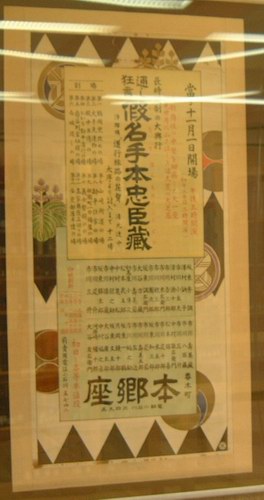 28-A
28-A
Kabuki poster for Kanadehon Chûshingura
Hongô-za, 1929
Tsubouchi Memorial Theatre Museum EB15-786
 28-B
28-B
Kabuki poster for Kanadehon Chûshingura
Kabukiza, November 3-27, 1951
Tsubouchi Memorial Theatre Museum EB15-265
29. Chûshingura and Film in Modern Japan
Until the advent of television in the 1960s, the Chûshingura story was the single most popular genre in modern Japanese film. It began in the 1910s with film renderings of kabuki dances from Kanadehon Chûshingura, but by the 1930s a distinctively modern film approach had been established, drawing more directly on the historical Akô Incident while incorporating many apocryphal legends from the kôdan storytelling tradition. And just as the kabuki tradition generated countless spin-off variants of the central Kanadehon Chûshingura lineage, so many films dealt with the exploits of individual members of the league of revenge. One of the many mainstream Chûshingura feature films was written and directed by Kinugasa Teinosuke and produced by Shôchiku, opening in December 1932. The poster for the film shown here (29-A) is particular notable for its innovative modernist typography and stylish design, featuring a lance with the kana “i” tag of the leader of the league, Ôishi Kuranosuke. The other poster (29-B) is for Genroku Chûshingura, a two-part film directed by Mizoguchi Kenji and based on a series of modern kabuki plays by Mayama Seika. Both the original plays and Mizoguchi’s film version aspired to a new level of historical accuracy, although a number of artistic liberties were taken with the details. The Mizoguchi film is also celebrated today for its distinctively “monumental style,” a slow and stately form of cinematography. The poster is for Part II of the film, which was released in January 1942, just after the beginning of war with the United States, and shows the scene in which the rônin offer the head of Kira (wrapped in a white cloth) before their master’s grave.
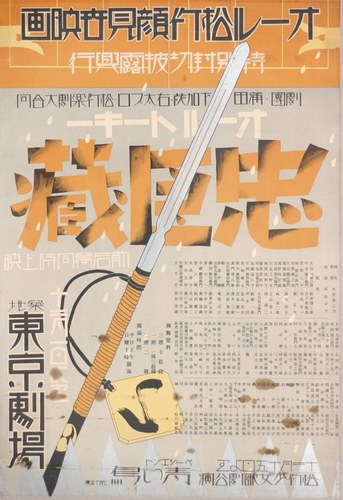 29-A
29-A
Poster for film Chûshingura
Directed by Kinugasa Teinosuke; 1932 Tsubouchi Memorial Theatre Museum M117
 29-B
29-B
Movie poster for Genroku Chûshingura, Part II
Directed by Mizoguchi Kenji; February, 1942
Tsubouchi Memorial Theatre Museum S1
